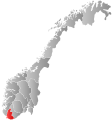Bjelland (municipality)
Bjelland herred | |
|---|---|
 Bjelland within Vest-Agder | |
| Coordinates: 58°22′48″N 07°31′40″E / 58.38000°N 7.52778°ECoordinates: 58°22′48″N 07°31′40″E / 58.38000°N 7.52778°E | |
| Country | Norway |
| County | Vest-Agder |
| District | Sørlandet |
| Established | 1 Jan 1902 |
| • Preceded by | Bjelland og Grindum Municipality |
| Disestablished | 1 Jan 1964 |
| • Succeeded by | Marnardal Municipality |
| Administrative centre | Bjelland |
| Area (upon dissolution) | |
| • Total | 164 km2 (63 sq mi) |
| Population (1964) | |
| • Total | 631 |
| • Density | 3.8/km2 (10.0/sq mi) |
| Demonym | Bjelldøl[1] |
| Time zone | UTC+01:00 (CET) |
| • Summer (DST) | UTC+02:00 (CEST) |
| ISO 3166 code | NO-1024 |
Bjelland is a former municipality in Vest-Agder county, Norway. The 164-square-kilometre (63 sq mi) municipality from 1902 until 1964 when it was merged into Marnardal municipality. It is now located in the northern part of the present-day municipality of Lindesnes. The administrative centre of the municipality was the village of Bjelland where Bjelland Church is located.[3]
History
The municipality of Bjelland was created on 1 January 1902 when the old municipality of Bjelland og Grindum was split into Bjelland (population: 907) and Grindheim (population: 909). During the 1960s, there were many municipal mergers across Norway due to the work of the Schei Committee. On 1 January 1964, Bjelland municipality was dissolved. The majority of Bjelland (population: 535) was merged with the municipalities of Laudal, Øyslebø, and a small part of Finsland to create the new municipality of Marnardal. At the same time, the Ågedal and Midtbø area of Bjelland (population: 96) was transferred to the municipality of Audnedal.[4]
Government
All municipalities in Norway, including Bjelland, are responsible for primary education (through 10th grade), outpatient health services, senior citizen services, unemployment and other social services, zoning, economic development, and municipal roads. The municipality was governed by a municipal council of elected representatives, which in turn elected a mayor.[5]
Municipal council
The municipal council (Herredsstyre) of Bjelland was made up of representatives that were elected to four year terms. The party breakdown of the final municipal council was as follows:
| Party Name (in Norwegian) | Number of representatives | |
|---|---|---|
| Labour Party (Arbeiderpartiet) | 2 | |
| Centre Party (Senterpartiet) | 7 | |
| Liberal Party (Venstre) | 4 | |
| Total number of members: | 13 | |
| Party Name (in Norwegian) | Number of representatives | |
|---|---|---|
| Labour Party (Arbeiderpartiet) | 2 | |
| Farmers' Party (Bondepartiet) | 7 | |
| Liberal Party (Venstre) | 4 | |
| Total number of members: | 13 | |
| Party Name (in Norwegian) | Number of representatives | |
|---|---|---|
| Labour Party (Arbeiderpartiet) | 2 | |
| Farmers' Party (Bondepartiet) | 5 | |
| Liberal Party (Venstre) | 5 | |
| Total number of members: | 12 | |
| Party Name (in Norwegian) | Number of representatives | |
|---|---|---|
| Labour Party (Arbeiderpartiet) | 2 | |
| Farmers' Party (Bondepartiet) | 6 | |
| Liberal Party (Venstre) | 4 | |
| Total number of members: | 12 | |
| Party Name (in Norwegian) | Number of representatives | |
|---|---|---|
| Labour Party (Arbeiderpartiet) | 3 | |
| Farmers' Party (Bondepartiet) | 5 | |
| Liberal Party (Venstre) | 4 | |
| Total number of members: | 12 | |
| Party Name (in Norwegian) | Number of representatives | |
|---|---|---|
| Labour Party (Arbeiderpartiet) | 2 | |
| Farmers' Party (Bondepartiet) | 6 | |
| Liberal Party (Venstre) | 4 | |
| Total number of members: | 12 | |
| Note: Due to the German occupation of Norway during World War II, no elections were held for new municipal councils until after the war ended in 1945. | ||
See also
References
- ^ "Navn på steder og personer: Innbyggjarnamn" (in Norwegian). Språkrådet.
- ^ "Forskrift om målvedtak i kommunar og fylkeskommunar" (in Norwegian). Lovdata.no.
- ^ Store norske leksikon. "Bjelland" (in Norwegian). Retrieved 21 November 2016.
- ^ Jukvam, Dag (1999). "Historisk oversikt over endringer i kommune- og fylkesinndelingen" (PDF) (in Norwegian). Statistisk sentralbyrå.
- ^ Hansen, Tore, ed. (12 May 2016). "kommunestyre". Store norske leksikon (in Norwegian). Kunnskapsforlaget. Retrieved 19 November 2020.
- ^ "Kommunevalgene og Ordførervalgene 1959" (PDF) (in Norwegian). Oslo: Statistisk sentralbyrå. 1960. Retrieved 19 November 2020.
- ^ "Kommunevalgene og Ordførervalgene 1955" (PDF) (in Norwegian). Oslo: Statistisk sentralbyrå. 1957. Retrieved 19 November 2020.
- ^ "Kommunevalgene og Ordførervalgene 1951" (PDF) (in Norwegian). Oslo: Statistisk sentralbyrå. 1952. Retrieved 19 November 2020.
- ^ "Kommunevalgene og Ordførervalgene 1947" (PDF) (in Norwegian). Oslo: Statistisk sentralbyrå. 1948. Retrieved 19 November 2020.
- ^ "Kommunevalgene og Ordførervalgene 1945" (PDF) (in Norwegian). Oslo: Statistisk sentralbyrå. 1947. Retrieved 19 November 2020.
- ^ "Kommunevalgene og Ordførervalgene 1937" (PDF) (in Norwegian). Oslo: Statistisk sentralbyrå. 1938. Retrieved 19 November 2020.
- CS1 Norwegian-language sources (no)
- Articles with short description
- Short description with empty Wikidata description
- Coordinates not on Wikidata
- Articles containing Norwegian-language text
- Articles containing Bokmål-language text
- AC with 0 elements
- Use dmy dates from November 2020
- Audnedal
- Marnardal
- Former municipalities of Norway
- 1902 establishments in Norway
- 1964 disestablishments in Norway


